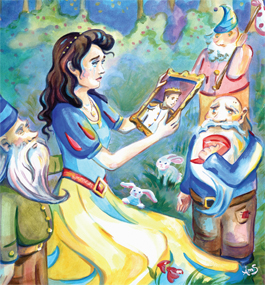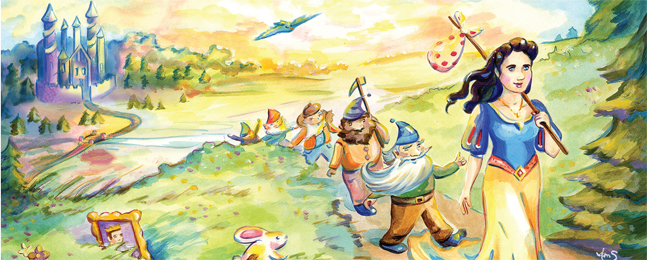How Walt Disney Ruined Our Love Lives
The myth of “happily ever after.”

Amanda Sharples
by Robert Epstein ’74
Thank you, Meryl Streep. Earlier this year, when you called Walt Disney out as a sexist and a bigot, you made it fashionable to criticize him, and I have a gripe you failed to mention.
Disney, you see, contributed to the failure of many marriages around the world. He did this by glamorizing and magnifying fairy tales that cause us — women, especially — to have unrealistic expectations about how successful romantic relationships are made and maintained.
Magnifying, indeed. Disney literally enlarged children’s books — “Snow White,” “Cinderella,” “Sleeping Beauty” — onto 2,000-square-foot screens. And he didn’t just enlarge the stories; he did some serious script doctoring to make sure we got the simplistic and, as I’ll show you, dangerous messages he wanted to convey.
Many of the original stories on which Disney based his films are about lives that are brutal and dark. After the prince marries the wrong woman in Hans Christian Andersen’s “The Little Mermaid,” a despondent Ariel throws herself into the sea and dissolves into the sea foam. In Giambattista Basile’s story of Sleeping Beauty, the already-married king eventually marries the young beauty, but only after she gives birth to twins — the outcome of his having raped her while she was still deeply asleep. The Grimm brothers’ tales about Snow White and Rapunzel are not sentimental and inspirational; they are creepy and complex, intended to warn children about life’s rough road.
Disney’s impact was so great that his movies have virtually obliterated the original messages. Millions of parents now read their children sanitized books that are based on the movie versions, not the original cautionary tales. As my kids would say, how whack is that?
Real relationships don’t involve knights in shining armor, soul mates, gleaming carriages, castles or, above all, living happily ever after. But the Disneyized tales now engraved in our consciousness make us feel these things are real, even after years of counseling in which our therapists beg to differ.
Our beliefs about relationships hobble us with expectations that are almost certain to be violated — the kiss of death for romantic relationships. A couple of years into a marriage, studies confirm that, on average, our love is about half as strong and we’re having sex half as often. Our partner doesn’t look or smell or behave anything like he or she did when we were dating. This person has changed, or so it seems.
Finally, one morning, we wake up and realize our partner is actually not “the one.” We have made a mistake, misled, perhaps, by false promises, a gorgeous smile or killer abs. All too often, that’s how we mate and split in the U.S.
I’m exaggerating the impact Walt Disney has had on our love lives, of course. He simply played an important part in a larger cultural shift. Today, we are bombarded daily by unrealistic messages about love and marriage — messages that make us think about leaving a relationship the moment our romantic expectations are dashed. As a result, nearly half of first marriages in the U.S. end in divorce. So do two-thirds of second marriages and three-quarters of third marriages.
Can anything be done? Or are we doomed, like Ariel, to be so miserable that we slowly dissolve into sea foam?
Taking control of our love lives
A few years ago, I was asked to speak at Maria Shriver’s last Women’s Conference, attended by 16,000 women — and me. Talk about scary.
Maria was familiar with research I had been conducting on how love can be built deliberately over time, and she thought this would be a great fit for the conference, the theme of which was “empowerment.” She titled my talk “Time to Take Control of Your Love Life.”
My message was that women had made great strides in realms such as education and work, but in the most important part of their lives — relationships — many were still entirely helpless, leaving everything to chance. The Fates will, or will not, bring Mr. Right to a woman’s doorstep, and she and her mate will, or will not, live happily ever after. Que sera, sera. I realize many people think this model is romantic, but to me it just sounds depressing.
Here’s a surprise: Most people in the world — in much of Asia and elsewhere — don’t think this way at all. Although in recent decades their thinking and practices have been altered somewhat by Western media, their childhood stories — the ones etching fundamental beliefs into their psyches — are still nothing like ours. Children learn traditional ideas like the importance of honoring family and revering ancestors, and they observe that successful marriages involve two people who are actually suitable for each other (imagine that) and who, with the help of extended family, often build a successful relationship over time.

Amanda Sharples
page 2 of 2
In the U.S., we say, “First comes love, then comes marriage, then comes baby in a baby carriage,” but in India, where more than 90 percent of marriages are still arranged by parents or matchmakers, people learn “First comes marriage, then comes love.” Research I’ve been conducting for a decade now confirms that in India and other countries where marriages are arranged many people do indeed build love deliberately over time. Yes, it can really be done.
Even though divorce is legal in India, the country has long had one of the lowest divorce rates in the world — a little over 1 percent per year — and studies confirm that arranged marriages generally have better outcomes than marriages set in motion by love. In one 1980s study in India, the love experienced in love marriages was compared with the love experienced in arranged marriages. In the former — and this is consistent with the findings of all relevant Western studies — love started out strong and weakened over time, but in the arranged marriages the opposite occurred. Five years in, the love in the arranged marriages equaled that in the love marriages. Ten years in, it was twice as strong.
We’re talking about two radically different trajectories here, each driven by different beliefs about what people can and cannot control. More than half the world’s marriages are arranged, with perhaps half of those eventually developing strong Western-style love. That’s a lot of love being experienced in about 350 million marriages — and a lot of power that people are exercising over their lives.
What many of these couples achieve is truly admirable, almost breathtaking. Consider an exchange I had with an urban, highly educated Pakistani woman about her arranged marriage. “On a scale from one to 10,” I asked, “where 10 is the most intense love you can imagine, how in love were you with your husband on the day you married?” This is a standard question in my research.
“Zero,” she replied.
“And how in love are you with him now?”
“Eleven,” she said, emphatically.
“And how long have you been married?”
“Forty-five years,” she replied.
Though this is a trajectory that is hard for Westerners to imagine, it is not uncommon in cultures in Asia, Africa and the Middle East.
In my most recent study, I ranked 36 factors that can contribute to the growth of love. The most powerful factors proved to be sacrifice, commitment and thoughtfulness.
Dozens of laboratory experiments conducted in the U.S. and elsewhere have confirmed that, generally speaking, almost any kind of interaction that makes people feel vulnerable in each other’s presence increases their emotional bond. When people fall in love, even in Western movies, it is virtually always because they have had multiple experiences together that have made them feel vulnerable. With every new experience of this sort, each person feels weak and defenseless, and simultaneously hopes or believes the other person will provide comfort rather than do harm. If comfort is indeed offered, the bond grows. Think about the bonding that occurs when two soldiers are in a foxhole, when people grieve over the loss of a friend or, more to the point, when a young couple rides the Space Mountain roller coaster at Disneyland.
Commitment, truly meant and honored, is the ultimate expression of vulnerability. What could possibly make you more open to harm than a solemn pledge to remain with someone until one of you dies, no matter what?
Packaging the process
Appearances notwithstanding, I am not a defender of arranged marriage, nor do I advocate it for Americans; we are too individualistic to make it work. Even though we will never practice arranged marriage, I believe we can benefit greatly by learning how people around the world routinely tame a beast many Westerners believe is too wild to even think of inconveniencing. I study arranged marriage because it is a living laboratory in which to learn about the process of building love.
From both my research and the research of many of my colleagues in the behavioral sciences, I have come to believe this process can be packaged in ways that will eventually empower millions of people in the West without importing arranged marriage itself.
There is a close precedent for this. In the 1960s and ’70s, the Beach Boys, the Beatles and many determined entrepreneurs helped introduce to the West a variety of techniques long used in Asia to improve well-being — meditation, yoga, tai chi and so on. They packaged these methods in terms and forms Westerners could understand and appreciate, and they did so without importing Asian religions or cultures. Now such techniques are embedded in our own culture, readily available to whoever wants to use them.
I believe we can do something similar for relationships: We can introduce into Western culture non-Western techniques for building love — exercises, counseling techniques, videos, workshops and rituals that will help us achieve what people in successful arranged marriages achieve (see sidebar).
 |
|
Sidebar Story |
 |
Once that happens, couples will see this new form of empowerment as an option. Though some will continue to gamble their happiness on the throw of the dice, others will choose to take control, using time-tested techniques to create a relationship that grows stronger over time, not weaker.
Now if we can only get rid of those fairy tales — or, better yet, create new ones that will inspire our children. Anyone have a good contact at Disney?
Robert Epstein, who earned a PhD from Harvard, is the former editor-in-chief of Psychology Today and the author of 15 books. He is currently senior research psychologist at the American Institute for Behavioral Research and Technology, in Vista, Calif. For more information about his forthcoming book, “Making Love,” and a related reality-TV project, visit MakingLoveBook.com. To take his compatibility test, visit AreWeGoodTogether.com. To participate in his ongoing research on arranged marriage, visit ArrangedMarriageSurvey.com.
